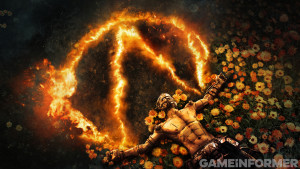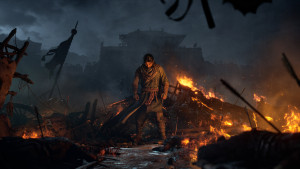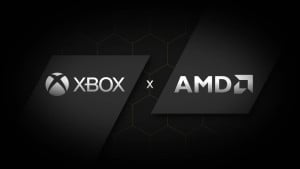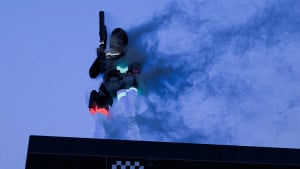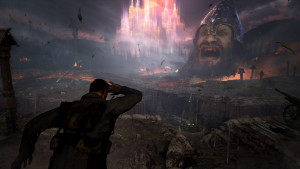Last chance for early bird pricing! Subscribe by June 25th to receive the debut issue
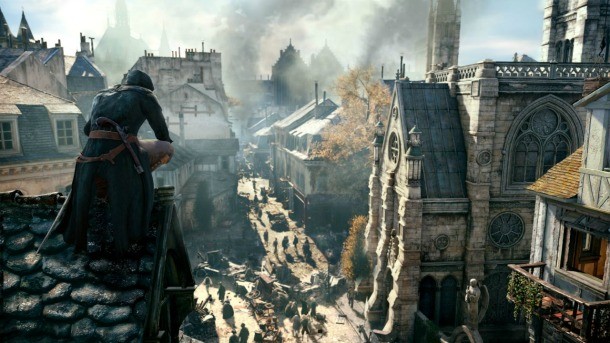
One of the fun surprises of Monday’s press conferences was the opportunity to see two distinct demos of Assassin’s Creed Unity in action. Today, I was shown a guided tour of each, and was able to glean a number of features that set the new game apart, both from previous AC entries, and from action games built for older generation consoles.
It’s Truly New-Gen
After seeing Unity in action, it’s easy to understand why the game is heading exclusively to PS4, Xbox One, and PC. Members of the development team explained that the core team for Unity got started right after the completion of Brotherhood in late 2010. From a completely reworked technical engine and visuals to a number of brand new features in navigation, combat, multiplayer, and mission structure, it’s a game that feels new-gen down to its DNA.
While many players enjoyed Black Flag, the new-gen versions were little more than visual upgrades. That same can’t be said for the fundamental shifts in gameplay and tech that characterize Unity. If you’re curious about a truly new-gen AC game, this is the project that will satisfy your questions.
The Setting
If you know your history, then you realize why the French Revolution is an amazing choice for an AC time period. For the historically challenged, the French Revolution is rife with awesome and awful bloody conflicts, and a turning point in western democracy and lawmaking. Moreover, as a French company, it’s likely that Ubisoft has a special interest in portraying this time period and location with care and detail.
As it’s presented in the game, Paris is a massive playground. If you don’t count the ocean, the sprawling cityscape of Paris, including its many interiors and underground catacombs, is twice the size of the world in Assassin’s Creed III.
The city is breathtaking, filled with some of the most beautiful man-made monuments you could imagine. I learned that locations like the Louvre, the Bastille, and the Gardens of Luxembourg are just some of the spots we know are in the game. We got a special glimpse inside Notre Dame Cathedral, which is breathtaking. Even with work yet to be completed on lighting, it’s a remarkable space to visit, even in a virtual world. When it’s complete, rays of sun will shine through the stained glass windows and reflect colored patterns directly onto the floor. All by itself, the cathedral is a huge playground, with a planned dozen different entry and exit points into the large space, from tunnels beneath the building to open paths at the top of the bell twoer – I can’t wait to visit the final version and explore all of its nooks and crannies.

A New Hero
Arno Victor Dorian is our new protagonist, and there are a few juicy details that Ubisoft shared with me about the new character. Arno is native Frenchman who was born in Versailles, the home of France’s royal family leading up to this tumultuous period. While we don’t know the specific circumstances, Arno is on a quest of redemption that brings him into the assassin’s organization, and that redemption is the focus of the story – the French Revolution is merely the background to that personal tale. The story is said to be going back to the structural roots of the series, with a narrative structure that has Arno slowly ranking up through the Assassins’ organization, a little bit like what we experienced with Altaïr and Ezio.
Cooperative Play
Perhaps the single biggest innovation in Unity is the introduction of four-player cooperative play throughout the campaign. What may not have been clear from Ubisoft’s early demos is how much this cooperative feature is entirely optional. Solo play is still a totally valid way to confront the game, but the option now exists to bring friends along if and when you want some company.
Here’s how it works. While wandering the world, you regularly enter taverns scattered around Paris. These taverns act as a social hub, and often have merchants from whom you can pick up new equipment. More importantly, if you have any friends currently playing Unity, you’ll see a “ghost” version of that player sitting about in the tavern. This indicates that player is out doing missions in their own instance of the game. You can approach their ghost and request to join their mission. If accepted, you are transitioned to their game and both of you reset to the most recent checkpoint, and continue on from there.
Up to four players can join together in this fashion. In your own game, you’ll always be Arno – the other players will look like random other members of your brotherhood. Lots of missions and activities are available for cooperative play, but there are some story missions that are set aside to be solo only.
Crowds
I prefer to avoid hyperbole when talking about a pre-release game, but there’s no two ways about it; Assassin’s Creed Unity has the most impressive crowd tech I’ve ever seen in a video game. Up to 1000 individual AI characters can appear in a crowd, each acting independently and reacting to each other and, more importantly, to your actions.
The crowd regularly presents all sorts of activities that you can choose to engage with at your leisure, but if you try to do them all, you’ll never make any progress in the rest of the game. You might interfere in a fistfight, or chase down a pickpocket. These situations emerge organically, and give you constant chances to get into some action.
Like previous games, many streets can have crowds through which you can sprint, while others are dense enough that it makes more sense to push your way through. Unlike previous games, Unity now includes truly dense crowds – groups so tightly spaced that neither you nor your enemy targets can run through them.
[Next Page: A Brand New Upgrade System]

Improved Movement
The AC Unity team claims that they’ve gone back to build the free-running system from the ground up. Many of the elements of this redesigned navigation system remain undetailed, but we did see one element – controlled descent. Designed to be an alternative to always having to look for hay stacks to leap into, controlled descents are meant to let Arno rapidly move down off an elevated position with ease.
In practice, this system seems to be very simple. To ascend a building quickly, the system is very much like it’s always been – hold RT and A. Controlled descent is now much the same, but you hold RT and B. The result looks especially cool, as Arno swings, clambers, and flips his way down along hand and footholds of a building or wall to reach ground level.
Upgrades and Customization
Unity is exploring a number of new, more RPG-like features in its customization system, with a special focus on making your version of Arno different from another player’s version.
To encourage this distinction between players, certain missions and activities now reward individual skill points, which can in turn be used to upgrade one of many active or passive skills, such as disguise, eagle vision, or lockpicking. In addition, many pieces of equipment offer skill bonuses, in addition to offering significant color and outfit changes that help your character distinct.
All this means that when you jump into the cooperative game, it’s very possible to coordinate your team of assassins to be ready for any situation, each with skill specialties that help to flesh out the team’s capabilities.
Mission/Activity Structure
Missions and side activities are built to be seamless experiences that you engage with or skip as you see fit. A quest log now stores potential quests that you might want to do, but at any one time only one of those is being actively tracked on your screen. In addition, your main story mission remains consistently tracked at all times to let you know where to head if you want to keep the narrative flowing.

New Navigation Choices
This new Assassin’s Creed includes a dramatically expanded number of interior buildings. In fact, we’re told that one in four of the buildings in Paris have interiors to explore. With so many building interiors to explore, movement through the city changes in some important ways. Because the ground is now often filled with large crowds, it’s more important than ever to move along rooftops or through interiors to arrive quickly at your destination.
Speaking of destinations, Unity also includes a brand new system for tracking things to do in the area. Run up onto a rooftop and stop moving for a moment, and you see a number of icons pop up onto the screen, showing you nearby objects of interests you could head toward. Instead of having to pull up the map, this system lets players continue moving through the world to new content without pausing to a separate screen.
New Ways To Confront Enemies
Ubisoft has put a premium on giving players numerous options for how to confront any given situation, especially when confronted with a group of enemies. A new cover mechanic assures that many potential combat situations can be bypassed entirely by carefully watching enemy sight lines and staying crouched behind cover. A new weapon, the phantom blade, offers a silent way to assassinate unaware targets from a distance. Once engaged in a fight, new combat moves are abundant, assuring even experienced AC players have some new approaches to explore; you’ll need the new tricks, since Ubisoft has completely overhauled enemy AI to make individuals more challenging, and groups attack in concert.
There are many aspects of Assassin’s Creed Unity that we still know nothing about, but this first deep dive into the gameplay left me feeling very positive about the game’s potential. I had mixed feelings about some of the choices made in Assassin’s Creed IV, but with just these short few viewings, Unity has catapulted high on my list of anticipated games. What are your thoughts about the introduction of Assassin’s Creed Unity? Share your thoughts in the comments below.


